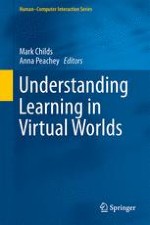2013 | OriginalPaper | Buchkapitel
4. An Examination of Student Engagement, Knowledge Creation and Expansive Learning in a Virtual World
verfasst von : Brian G. Burton, Barbara Martin, Jenny Robins
Erschienen in: Understanding Learning in Virtual Worlds
Verlag: Springer London
Aktivieren Sie unsere intelligente Suche, um passende Fachinhalte oder Patente zu finden.
Wählen Sie Textabschnitte aus um mit Künstlicher Intelligenz passenden Patente zu finden. powered by
Markieren Sie Textabschnitte, um KI-gestützt weitere passende Inhalte zu finden. powered by
